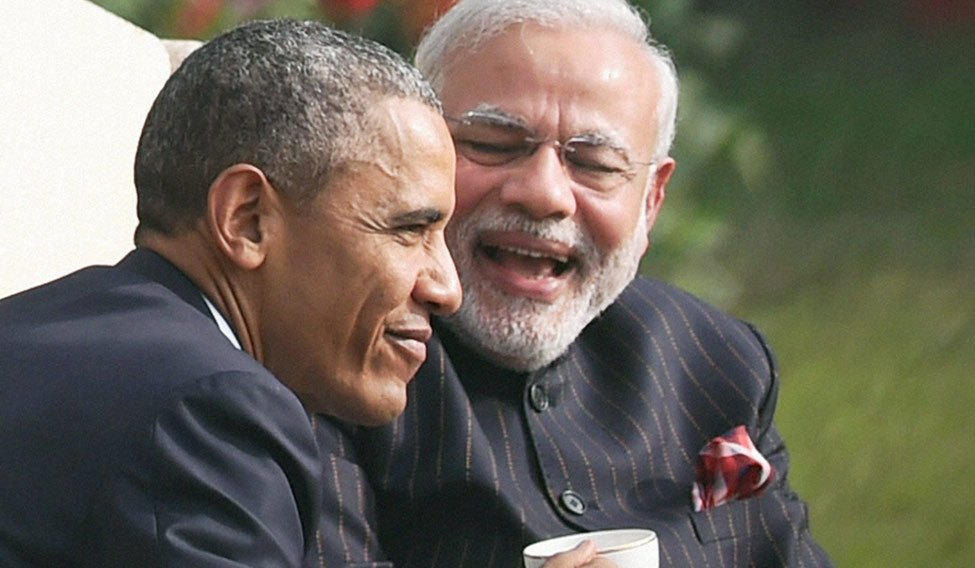Prime Minister Narendra Modi’s voice takes on a honeyed tone every time he utters his “good friend’’ Barack Obama’s name. He calls the outgoing president Barack, showing scant regard for protocol and convention.
The Modi-Obama bromance has been the public face of India-US ties in recent times. US Ambassador to India Richard Verma described the last two years as the best in bilateral relations. In a recent communique, he highlighted a ten-day period in August 2016 during which Obama and Modi met twice, first at the G-20 summit in Hangzhou, China, and then in Laos at the East Asia Summit, bringing their official meeting count up to eight. At the same time, American Secretary of State John Kerry and Secretary of Commerce Penny Sue Pritzker were in Delhi for the second annual strategic and commercial dialogue and Defence Minister Manohar Parrikar was in Washington, DC, meeting with Defence Secretary Ash Carter to finalise a long-pending logistics agreement.
The quickly-forged-and-as-quickly-tested personal rapport between the two leaders (the Paris climate deal deadlock was resolved when Obama phoned Modi) lent a much needed personal touch to dealings that are complex and take a lot of deliberation before reaching the table for signatures.
However, the present level of engagement between the world’s oldest and largest democracies was not altogether wrought over sipping tea in manicured lawns or jointly addressing Mann ki baat on radio. It is the culmination of an effort that began at the end of Bill Clinton’s second term and was taken forward by his Republican successor George W. Bush before the baton passed to Obama. On the Indian side, too, the relations have been nurtured by ideologically very different governments, starting at the end of the Vajpayee regime, sailing through two UPA terms before Modi took over. It was under Bush that the civil nuclear deal was forged, which helped India get a waiver from the Nuclear Suppliers’ Group and could lead to American investment in India’s future nuclear plants.
While Manmohan Singh’s style of engagement may not have been as flamboyant as his successor’s, Obama had a quiet respect for him and his intellect. And Michelle Obama danced her way into Indian hearts during her first visit itself as she took off her pumps and shook a leg with street children at a Diwali gathering in Mumbai in 2010.
Nonetheless, there is an energy in the engagement between both nations at present, in every sphere from strategic to economic. The bilateral ties were recently upgraded with India being designated a major defence partner of the US. This status, unique to India, will facilitate technology transfer and defence trade, to take it to almost the same level that the US has with countries with which it has defence treaties.
Some of president-elect Donald Trump’s moves may jeopardise the progress in bilateral ties, climate change mitigation and clean energy being the major concerns. The US, in return for India’s help in finalising the Paris Agreement—a legacy that Obama wanted to leave behind—has committed to financial and technological investments in Modi’s international solar initiative, a bid to upscale clean energy production in solar rich countries. India and the US have signed numerous deals for cooperation in developing clean energy solutions, including the Partnership for Climate Resilience and the Fulbright-Kalam Climate Fellowship.
Trump’s appointment of climate change sceptic Scott Pruitt to head the environmental protection agency does not generate much confidence. Experts note that it may be difficult for Trump to renege from key commitments of the previous regime, although being compelled to honour a commitment of the past regime could make Trump hostile. India, however, has done the balancing act in the past, say observers.
India has had another interesting experience with American presidents, who tend to warm up to India in their second terms. It was only towards the end of his presidency that Clinton showed interest in India, post the Kargil war, and made the historic visit in 2000, which was the first American presidential visit in 22 years. It set rolling a process that has resulted in the present-day bonhomie. Bush was preoccupied with Afghanistan during his first term, thus Pakistan was his priority. Term two, he kept for India and crafted the nuclear deal. Although Obama did visit India in his first term itself, he truly opened up to India in his second term. And the last two years became what might be remembered in later years as “historic’’.
Trump may be a man in a hurry, but he would soon realise that when it comes to India, the old-fashioned, arranged marriage system works best. This isn’t the country for which a quick fix Vegas style marriage works. Now, this is the point at which we wonder whether one term is enough for Trump to understand India.
One thing, however, is certain. While bilateral ties may simmer at a slow pace, gradually releasing flavours, the two leaders aren’t likely to waste much time developing some sizzling personal chemistry. Modi rushed to the phone to congratulate Trump on his victory. After all, Trump began his India wooing by modifying Modi’s own victory chant, abki baar Trump sarkar.






